Although one of the most common tools used on a construction site, in a warehouse, or in a shop, if improperly used, step ladders can lead to serious injuries or even fatal incidents.

A step ladder requires level ground support for all four of its side rails. If this work site condition does not exist, a stepladder should not be selected for the job.
To determine the correct step ladder to use, consider your weight plus the weight of your load. Do not exceed the maximum load rating of the ladder and always include the weight of all tools, materials and equipment.
Step Ladder Hazards
Common Step Ladder Hazards:
- Damaged step ladder
- Ladders on slippery or unstable surface
- Unlocked ladder spreaders
- Standing on the top step or top cap
- Loading ladder beyond rated load
- Ladders in high-traffic location
- Reaching outside ladder side rails
- Ladders in close proximity to electrical wiring or equipment
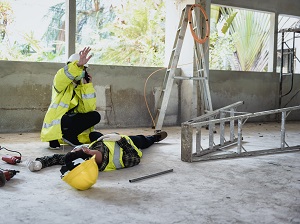
Inspecting Your Step Ladder
Always inspect every step ladder prior to using it. If the ladder is damaged, it must be removed from service and tagged until repaired or discarded. Never use a damaged ladder!
Step ladders with structural defects or are otherwise not safe for use must immediately be marked defective or tagged with “Do Not Use” (or similar language) and removed from service until repaired. If the step ladder will not or cannot be repaired, it should be destroyed and discarded.
OSHA Standard 1926.1053(b)(16) Portable ladders with structural defects, such as, but not limited to, broken or missing rungs, cleats, or steps, broken or split rails, corroded components, or other faulty or defective components, shall either be immediately marked in a manner that readily identifies them as defective, or be tagged with "Do Not Use" or similar language, and shall be withdrawn from service until repaired.
The anti-slip feet at the bottom of the step ladder side rails must all be present and in good condition. If the climbing and gripping surfaces of the step ladder are smeared with oil, grease or any other substance that could make the ladder slippery, the ladder must be cleaned before use.
Ladders that have been exposed to excessive heat (like a fire) or corrosive substances (like acids or alkali materials) may have reduced strength and should be removed from service.
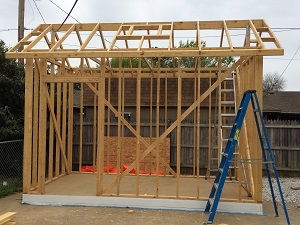
Using a Step Ladder Safely
Read and follow all the instructions and warnings on the ladder. Before climbing on any step ladder, think about where and how it will be set up for use.
Do not use ladders on slippery surfaces unless secured or provided with slip-resistant feet to prevent accidental movement. Do not use slip-resistant feet as a substitute for exercising care when placing, lashing or holding a ladder upon slippery surfaces.
Avoid electrical hazards! Look for overhead power lines before handling or climbing a step ladder. Do not use a metal step ladder near power lines or electrical equipment.
Do not use a step ladder in a partially open position. The base must be spread fully open with the spreaders locked.
OSHA Standard 1910.23(c)(7) The employer must ensure that ladders placed in locations such as passageways, doorways, or driveways where they can be displaced by other activities or traffic are secured to prevent accidental displacement are guarded by a temporary barricade, such as a row of traffic cones or caution tape, to keep the activities or traffic away from the ladder.
When it is necessary to set up a step ladder in an area like a passageway, doorway or driveway, the ladder should be secured, and the area should be barricaded to keep traffic and pedestrians away from the ladder to prevent accidental movement.
Never place a step ladder on other objects, like boxes, shelving, scaffolds or pallets, to try to gain more height to access the work area.
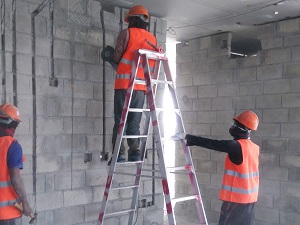
Only use ladders and appropriate accessories, like ladder levelers, jacks or hooks, for their designed purpose. Do not use a folded step ladder as an extension ladder. Do not use a step ladder horizontally, like a platform.
OSHA Standard 1926.1053(b)(4) Ladders shall be used only for the purpose for which they were designed.
Do not use cross bracing on the rear section of step ladders for climbing unless the ladder is designed with steps for climbing on both front and rear sections.
Do not move or shift a step ladder while a person or equipment is on the ladder.
Do not leave tools, materials, or equipment on a step ladder when the ladder is not in use. It is very easy to forget about them and when the ladder is shifted the objects can quickly become falling object hazards.
Storage racks for ladders not in use should have sufficient supporting points to avoid sagging which can result in warping the ladder. Other materials must not be placed on the ladder while it is in storage.
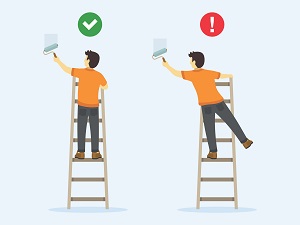
Do not stand on the top step or cap of a step ladder. Stay near the middle of the ladder and always face the ladder when climbing up or down.
Maintain a 3-point contact (two hands and a foot, or two feet and a hand) when climbing up or down a ladder. Use at least one hand to grasp the ladder when climbing.
OSHA Standard 1910.23(b)(12) The employer must ensure that each employee uses at least one hand to grasp the ladder when climbing up and down it.
Avoid over-reaching while on a ladder. If the work requires over-reaching or precarious balancing, then the ladder should either be moved, a different ladder should be chosen that is more suitable for the task, or an alternate way of completing the task should be determined.
Do not carry objects or loads while climbing a ladder that could cause loss of balance. Never attempt to move the ladder without first descending, relocating the ladder, and then re-climbing.
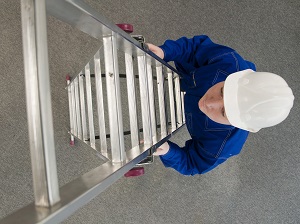
.jpg)

.jpeg)